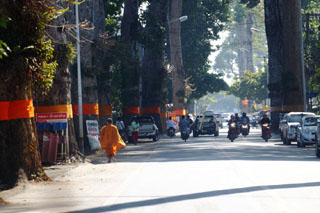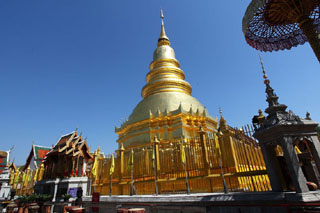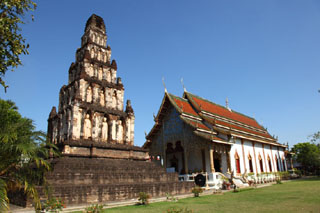Thailand - Lamphun
Photo Gallery of Lamphun, the calm and peaceful place, in Thailand.
Lamphun is one of the oldest cities in Thailand and is well-known as the first royal city of Northern Thailand. It was called "Haripunchai" and flourished for a long time.
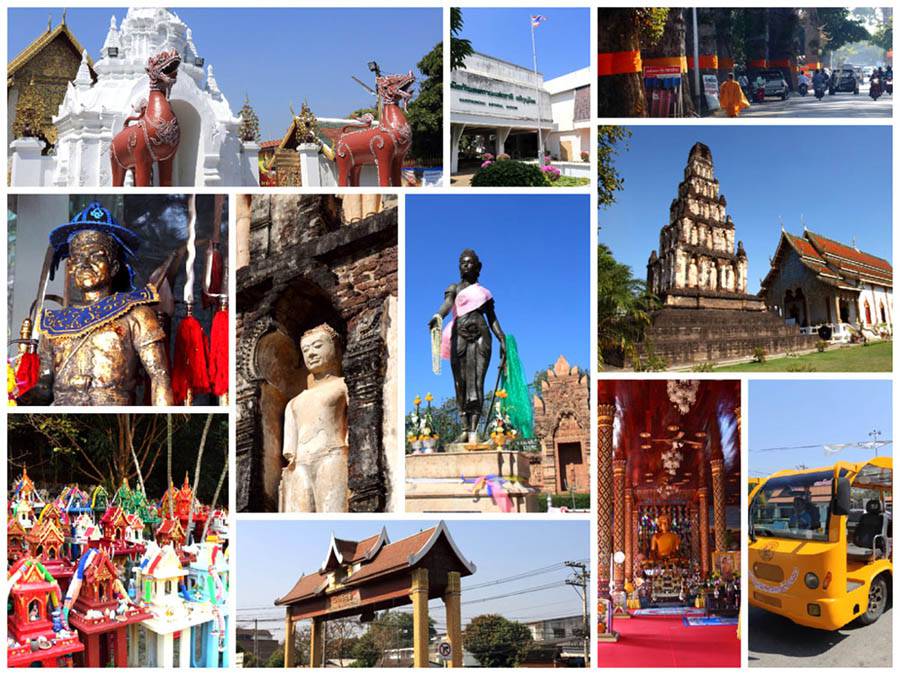 The town is very peaceful, situated along Kuang River (tributary of Ping River), about 30 kilometers and about 30 minutes by car from Chiang Mai, the major city in northern part.
The town is very peaceful, situated along Kuang River (tributary of Ping River), about 30 kilometers and about 30 minutes by car from Chiang Mai, the major city in northern part.(When you go to Lamphun by car from Chiangmai, you'll see a lot of big trees on the both sides of the street which were offered by a prince of Chiang Mai in 1899, blessed with Buddhist orange swathes.)
Now, let's see what kind of place Lamphun is beforehand such as its history.
- History of Lamphun:
Lamphun was known as Hariphunchai, the first royal city of northern Thailand. Before Haripunchai, this area was called hSamantra prathet" and after the fall of it, the city was recovered as "Hariphunchai Nakorn" around 661 A.D. (some believe it was around 750 A.D.) In 663, Princess Cham Thewi (or Chama Thewi or ChamDevi; daughter of the King Of Lawo or Lawapur) was invited to become a queen in 663 A.D. , then the Haripunchai kingdom started and lasted for about 620 years.
Hariphunchai was the original base of Lanna's civilization which cultivated things such as Buddhism, economics, politics, rules, arts, culture and armies. The alphabets of their language was the origin of ancient Mon alphabets, and influenced Burmese and Mon alphabets at present as well. Furthermore, they became the origin of Thai alphabets 400 years later in Sukhothai period, and of Lanna alphabets in the northern Thailand.
In 1281, Haripunchai was invaded by King Mengrai of Lannathai and got to be a part of his kingdom (the capital was Chiang Mai). Then, in the 16th century, Burma (current Myanmar) invaded this region and Lannna Thai kingdom including Haripunchai was occupied for more than 200 years.
In 1795, after King Ja Baan and King Kawila took Chiang Mai from Burma (Myanmar), they decided to renovate Hariphunchai which was an abandoned city at that time. After the renovation was finished, the name of the city was changed to "Lamphunchai". Including people of Chiang Mai and Lampang moved to that location, King Kawila went north to SibsongPanna which was ruled by Burma (Myanmar) and drove out around 10,000 Tai Lue people from Yong region to Lamphun. Yong people brought with them Sibsongpanna culture which included costume, language, music, dance, food, etc. of Sibsongpanna.
(When they arrived in Lamphun, it was around April of 1806. In 2006, Lamphun celebrated the 200th anniversary of Yong people establishment.)
In 1894, in the period of King Rama V, all Northern cities such as Chiang Mai, Lampang, Nan, and Phrae including Lamphun, were united in Payap region. Later in the period of King Rama VII in 1929, the central government revised local government administrative rules, and provincial system was established. Since then, Lamphun has become one of Thailand's provinces.
Hariphunchai Nakorn has been the biggest living center of the southeastern region. People in this area were from different races and classes: Indian, Roman, Yunnan, Dongson, Mon, Kmer, Lavo, Thai Lue, Yong, Shan, Siam, Chinese etc. When compared with other kingdoms founded in the same period of time, no other kingdoms had as many different ethnic groups of people as Hariphunchai Nakorn had.
Lamphun in the present time; however still considers these minor groups; Thai Lue, Mon, Yonok, Karen, Lawa, Yong, Shan as important. In addition, these minor groups still live traditionally due to their values.
- Legend and Name
Legend has it that during the Buddha's lifetime, he came to gather alms in this area and had fruits called "Samor" (fruit of the tree of the genus Terminatia) offered to him by a Lua tribesman. Buddha predicted that there would be a man who would erect a city at that spot and name it "Haripunchai Nakhon". Later there were tow hermits named "Wasuthep" and "Sukkatanta" who built the city and named it Hariphunchai Nakhon, (meaning a city that Lord Buddha used to have Samor fruit), in B.E. 1204 (661 A.D.). The word "Hari" means "Samor fruit" and "Phunchai" means "consume" and the last word "Nakhon" means "city".
- Buddhism
Prior to Hariphunchai period, Lua people worshiped Taen Spirits of Ancestor Spirits called "Phii Pu Se Ya Se". Later on, Hinduism was brought, then, in Hariphunchai period, Mahayana Buddhism was established for the first time in the North of Thailand and then changed to Theravada, Lanka Wong, Raman Wong, Sihol, etc.
(Theravada Buddhism in Thailand, on the other hand, Mahayana Buddhism in Japan.)
The first beam of Buddhism occurred when the Buddha's hair was found in Wat Phra That Hariphunchai. In the period of King Athittayarat (around A.D 957), he established the first pagoda which contained the remains of Buddha in the North of Thailand. Traditionally, every king of Hariphunchai dynasty must worship the pagoda before the coronation. Even Tibetan monks of Himalaya had to come and worship this pagoda of Haripanja or Hariphunchai annually. This reflected that Lamphun was the center of Buddhism in Ping, Wang, Yom, Nan river basins, as well as in Khong and Salawin river basins.
Until today, Lamphun was the center of Buddhist civilization of Lanna. The centers today are at Wat Phra That Hariphunchai, Wat Phra Phuttabat Tak Pha in Pasang district and Wat Phra Phuttabat Huay Tom in Li district. The pagoda at Wat Phra That Hariphunchai is especially recognized as the oldest pagoda. This pagoda was praised by King Rama IV who stated that it was one of the eight famous pagodas in Thailand.
- Heritage to the World !
The importance of Lamphun is in various levels: local, nation, regional, and continental. It can be promoted to "World Heritage" according to the UN's criteria for cultural heritage sites so that people in Lamphun are alert to preserve this cultural heritage. Skill labors of Hariphunchai are praised by artists and art historians around the world that they are the best creators of ancient art objects. They represent the beauty of harmony and spirit.
The uniqueness of Lamphun historical city is architecture. All types of the architecture are the prototypes for upper and lower Northern regions like Lanna, Sukhotahi, and Ayudhya. Original pagodas are :
- Stepped pyramid at Wat ChamDevi,
- Octagon-shaped pyramid at Wat ChamDevi,
- Five-topped pagoda (Chiang Yan pagoda),
- Lanna style bell-shaped pagoda at Wat Phra That Hariphunchai.
My first impression of Lamphun was, "Fantastic. Not big too much. Cozy and peaceful". Still, it has a very long history and was remarkably influential on the surrounding vast areas. ( Wow. What a surprise !)
It's very close to Chiang mai. Why don't you drop by Lamphun when you come to Chiang mai ? :D
|
Let's check around with me !
Gates, Wall, and the Town |
The royal temple in Lamphun - Wat Phrathat Hariphunchai |
The final resting place for the queen - Wat Cham Thewi
|
||
The city, Lamphun, still has old city gates and walls because it was a
capital city of Haripunchai kingdom long time ago. (It's like Chiang Mai city. Or Lamphun has an older history and is it better to say Chiang Mai looks like Lamphun, isn't it ?)
I didn't know this was all but when you go around the town along the moat, you'll see gates around ... |
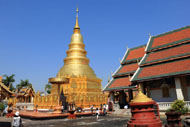
The temple has a huge pagoda, the first pagoda which contained the remains of Buddha in the North of Thailand. Traditionally, every king of Hariphunchai dynasty must worship the pagoda
before the coronation. Even Tibetan monks of Himalaya had to come and worship
this pagoda annually also. The pagoda was greatly influential
... |
This temple is called "Wat Cham Thewi" or "Wat Kukut" after the well-known chedi in this temple. It was constructed around
the 13th C.A.D. during Haripunchai kingdom period. It has two famous chedis,
1. Chedi Kukut, 2. Ratana Chedi. I hear that Lamphun's cultural heritage
sites can be promoted to "World Heritage". ...
|
||
|
The Beloved Queen of Lanna people - Chama Thewi
|
The history of Lamphun - Hariphunchai National Museum
|
With a chedi on a hill - Wat Phra Phutthabat Tak Pha | ||
This area was called hSamantra prathet" long before Lamphun. After
the fall of it, the city was recovered as "Hariphunchai Nakorn" around 661 A.D.
In 663, Princess Cham Thewi was invited to become a queen in 663 A.D. , then the Haripunchai kingdom
started. She brought civilization from Dvaravati to Northern Thailand for ...
|
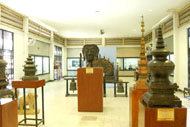
The museum has the main building and other building. In the main building,
you'll see various exhibits such as Buddha images in Haripunchai style,
Lanna style and Lopburi style, Terra-cotta Buddha images, Stucco in Dvaravati
style, sandstone objects, pottery and prehistoric remains. Other building
shows the history and ...
|
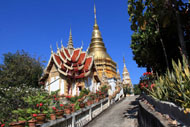
Wat Phra Phuttabat Tak Pha is located in Pa Sang, about 14 kilometers in the southwest of Lamphun
city. It's a unique temple with a vast ground and a chedi called Phrathat Chedi Si Khruba on a hill from where you can look over Lamphun. Fantastic !
If you understand Thai language, you can imagine what kind of ... |
||
|
The image seated under Naga's hood - Wat Mahawan
|
The brave worrier on the hill - San Chao Por Khun Tan
|
|||
Constructed in 657 A.D (1200 B.E.) by the queen Cham Thewi, the first ruler of Hariphunchai kingdom.
This temple is famous for the image of the Buddha seated under the Naga's hood which is believed to be Phra Phutta Sikkhi or Phra Sila Dam (The Black Stone Image) taken from Lawo (present Lopburi in the center of Thailand) by Phranang Chama Thewi, ... |
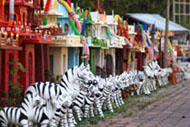
Do you know there is a small but well-known shrine around the border between
Lamphun and Lampang ? It's called "San Chao Por Khun Tan or Chao Por Khun Tan Shrine". The King Paya Berg or Chao Por Khun Tan is enshrined here. He was
a very brave worrier and people believe that this place realize your wishes.
(If wishes come true, people present something ...
|
|||
